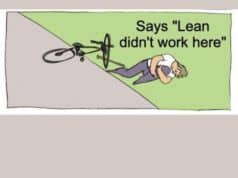Voting glitches feared on Nov. 7 | Chicago Tribune
Why is Lean such a powerful methodology? I think part of the reason is because it's so rarely applied in the “real world” — the notions of good system design and error proofing aren't found very often. People usually design lousy systems and expect people to “be careful.”
Look at the mess they are expecting in Chicago:
“The most likely stumbling block for a smooth election remains a small device that is supposed to consolidate totals from two voting systems and transmit the results downtown via cellular technology. In the spring, many judges couldn't get it to work.
And it will still be possible for workers to accidentally fry vote totals if they forget to disconnect the power from ballot scanners before data cartridges are removed at the end of the night.
“We don't want you to erase any of the memory,” warned Gail Weisberg, Cook County's equipment manager coordinator, during a training class last week in Hoffman Estates.”
It sounds like we have a technology that violates one of the Toyota Way principles, the idea that you should only use reliable, thoroughly tested technology that serves your people and processes. This voting technology sounds like technology for technology's sake.
The voting hardware is not error proofed — it should have been designed to consider that it would be possible to pull the memory out with the power on. During the design phases, especially for something as important as voting, the designers should have gone through an FMEA (Failure Mode Effects Analysis) exercise to think “what could go wrong?” so they could build in protections against those “user error” mistakes.
“While they suggest major improvements have been made, officials say politicians, voters and the media should never expect the new system to operate as quickly as when paper ballots were used and 90 percent of precincts typically reported results within an hour of polls closing.”
How in the world do you design an electronic system with a SLOWER cycle time than the old paper ballots system?
So let's see: The newer technology is unreliable, difficult to operate, fails easily, and is slower. Why did they even implement this new techology? (Please limit your answers to those avoiding political conspiracy theories).
The real answer:
The changes were required by the federal government after problems in the 2000 presidential election with punch-card ballots and antiquated voting machines in Florida and elsewhere.
Oops. So let's replace a bad technology and process with a different bad technology and process.
“Most of the inability of the HAAT devices to successfully transmit data on election night was due to operator error,” the Freeman, Craft, McGregor Group wrote in its report.
So they blame human error. NOT a good excuse. In the Toyota Production System mindset, you recognize that people are human and you design the system accordingly. Error proofing methods make sure that it is tough (or impossible) for people to make mistakes.
I'm sure they can just provide better training, right?
Still, as the latest version of the HAAT was approved by the State Board of Elections at an emergency meeting Friday, there was testimony that even those who regularly work with election equipment could not get it to function properly.
“I followed the steps and the steps didn't take me to where I needed to be,” said Dianne Felts, the state board's director of voting systems and standards.
Felts said that in one round of testing, 16 of 19 precincts failed to properly consolidate in the HAAT because there were differing versions of software installed in the machines. “It was easily remedied, but it was another human error,” she said.
We have operator instructions (Standardized Work) that either can't be followed or don't work. We have a lack of standardization in the voting machines (different versions of the software) that prevent them from working (and again “human error” is blamed).
I could go on and on, no I already have. How incredibly frustrating that our democracy hinges on poorly design systems. We have to teach people to do better.
What do you think? Please scroll down (or click) to post a comment. Or please share the post with your thoughts on LinkedIn – and follow me or connect with me there.
Did you like this post? Make sure you don't miss a post or podcast — Subscribe to get notified about posts via email daily or weekly.
Check out my latest book, The Mistakes That Make Us: Cultivating a Culture of Learning and Innovation:










You are correct. And that is just talking about the vote processing process – to say nothing of improving the decision making in selecting who to vote for :-)
I posted on the Curious Cat Science and Engineering blog about this: Security of Electronic Voting. Another related post on TiVo Designing In Errors.